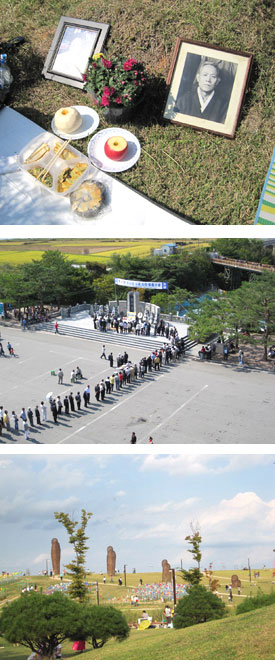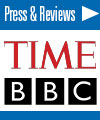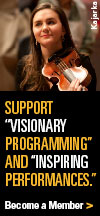Eye of the Storm: Chords of Memory – Reclaiming One’s Identity
by Sung Jin Hong

Photos by Adrienne Metzinger, Korea 2009
TOP: Paying respects to my ancestors at the gravesite of my grandfather during Chuseok
CENTER: South Koreans honoring their North Korean ancestors at the DMZ as they cannot visit their graves in North Korea.
BOTTOM: Outdoor sculpture displayed at the DMZ in South Korea.
Similar to Henry DeTamble in Audrey Niffenegger's The Time Traveler's Wife (2003), I run almost every day to keep myself balanced and remain focused in the moment. When I ran in a marathon during the visit to my homeland Korea for the first time in twenty-five years, I heard Korean drummers and dancers interacting with a pulsating rhythm. The same rhythm was played by a monk using a wood block while meditating in a Buddhist temple. The obsessive rhythm became the birth of Eye of the Storm (2010).
Eye of the Storm unites the experiences during my marathon, a visit to a Buddhist temple, and explores the intense experience of my last full day in Korea: revisiting my grandfather's grave and setting foot into the Demilitarized Zone. When I visited the DMZ, it happened to be on the weekend of Chuseok, a major harvest festival during the Autumn Equinox. Comparable to Thanksgiving, Chuseok is the most important holiday in Korea.
Chuseok is also a time when families visit their ancestors and pay respect towards them. I have fond childhood memories of our family and relatives gathering together at my grandparents' grave. We would sing, pray, laugh, play games, and of course, the best part was eating so much delicious food. It was a time of remembering our ancestors and celebrating life with family and loved ones. Each member of the family took turns bowing and pouring my grandfather's favorite soju (a Korean rice vodka) onto his grave.
On the last full day of my pilgrimage to Korea, my uncle Won Hee Lee took his family and my wife Adrienne and me to visit my grandfather again. The last time I visited him was almost 25 years ago, which was when our family emigrated to the United States. It was exactly the way I remembered it. But now there was an acute awareness of how much I missed my homeland and heritage. I just dropped and bowed, which is part of a Confucian practice of showing gratitude towards ancestors. Some may feel that bowing to ancestors is an antiquated ritual and may conflict with one's own religious or non-religious beliefs. It really didn't matter; I came from my grandfather and he continued to bring family and friends together to perpetuate and strengthen relationships. As an adult, I expected my visit to my grandfather's grave to be another ritual that I should do but I was deeply moved by visiting him again.
Then, my uncle took us to the DMZ, which many people consider it to be Tolkien's Mordor on earth. The DMZ in reality is peaceful and even beautiful. Since hardly anyone steps foot onto this area, nature can grow without interference from humans and animals can roam freely. During Chuseok, Koreans separated from their ancestors and families by the 38th parallel come to the DMZ and pay homage to their lost loved ones. It was moving to witness some of the pain of separated families being reunited in spirit.
The climax of Eye of the Storm reaches an end at the DMZ. It depicts my personal experiences being in one of the tunnels that North Korea has dug underground. A friend recently asked me if Eye of the Storm is a political statement. That's for the listener to decide. Eye of the Storm has become a cross-cultural symphonic poem pursuing a critical awareness of one's own heritage and current day conflicts of one's homeland. I have discovered the pursuit of reclaiming one's cultural identities is complex and is often both a spiritual and intellectual process. Similar to the teachings of Martin Luther King, Jr. and Malcolm X emphasizing multi-cultural awareness during the Civil Rights Movement, Eye of the Storm seeks a world full of possibilities with multiple perspectives even in the complete darkness from one of tunnels of the DMZ.
Eye of the Storm was written during the summer of 2010. It is scored for three flutes, piccolo, two oboes, English Horn, two clarinets, bass clarinet, two bassoons, contrabassoon, four French Horns, two trumpets, two trombones, bass trombone, harp, timpani, Buk, tam-tam, suspended cymbal, bass drum, wood block, strings, and audience.
Eye of the Storm is commissioned by West Village Concerts.





